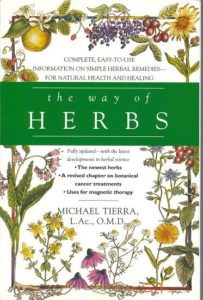
The Way of Herbs / by Michael Tierra. Pocket Books, 1998. 375 p., Illustrations, Tables, Bibliography and Index.
Herbalist and Oriental Medical Doctor, Michael Tierra, offered a wonderful book first published in 1980, The Way of Herbs, successively reprinted 3 times and revised for this 1998 edition. Combining the tradition of early twentieth century botanists who knew much about medicinal plants on two continents, The Way delivers herbs from both Eastern and Western traditional herbalism. The eighth chapter, “Kitchen Medicines”, reviews well known and loved spices adding genuine wisdom that is ancient in origin, that is shared East to West and vice versa. It follows introductory chapters concerning the use of herbs, their actions, methods of preparation, and the herbalist’s diagnosis. Some of the uses of 22 kitchen herbs are grouped here due to the warming property for such spices as cayenne, cardamom, cinnamon, cloves, garlic and ginger. A warming property is known as stimulating, or increasing the action for the circulatory, digestive and nervous systems. Otherwise, an existing warmed condition, a pain or inflammation also responds to herbs of a cooling, rather than warming nature. Did you know that headaches can be treated with the use of cardamom, marjoram, or rosemary in medicinal teas? In fact rosemary is featured in herbal formulas for the treatment of headaches that also use nerve-relaxant herbs.
Kitchen herbs that help in the expulsion of mucous in the lungs, or expectorants include anise, fennel, fenugreek and garlic. Also having antispasmodic properties, they’re good for intestinal gripping. Coriander and cumin have carminative (gas-reducing) action. Some herbs, like cardamom, cinnamon, sage help with diarrhea.
Kitchen medicines have stimulating (increase circulation) or alterative (purify the blood) properties too. Stimulants include anise, basil, black pepper, cayenne, cinnamon, garlic and sage. Alteratives found in Western herbs include burdock root, comfrey, goldenseal, and nettles. Kitchen medicines with alterative properties include basil, coriander, garlic and turmeric.
The chapter on Western herbs lists a number of botanical medicines from leaves, stems, bark, root and fruits. Berries, such as raspberry, blackberry and bilberry offer medicinal properties such as astringent quality from the leaves while the fruit provides nutritive value. Fruits from loquat, mulberry, noni, papaya, and passionflower are available as luscious foods, but loquat leaves have an affinity for the lungs and mucous; mulberry leaves, twigs, and bark for nervousness and anemia. Noni leaves, flowers, bark and seeds are tonic for immunity, digestive disfunction and gum disease; passionflower’s leaves are anti-spasmodic and can be mildly sedative.
The author chose to illustrate the benefits of about 30 Chinese herbs. In this group are several medicinal herbs also used as food, among them jujube dates, longan berries and licorice. Citrus peel and apricot seed have highly regarded medicinal properties. Flowers of chrysanthemum and honeysuckle, and the roots of peony are well-regarded for the blood and bell-flower (Platycodon) for the lungs.
Michael Tierra’s ultimate focus is on the powers and properties of the herbs, rather than on human bodily ailments as a means of discussing herbal benefits. The Way of Herbs provides many avenues of approach to learning about their medicinal properties; one of the most appealing being his approach to herbs as food. Tierra’s herbal provides chapters on the “Theory of using herbs”, “Herbal therapies”, “Methods of application” and “Herbal properties” to support “Balanced diet”, “Kitchen medicines” before the main chapters on the herbs from the West and from Chinese traditional medicine. You will also find here a few chapters with how-to advice: “Obtaining and storing herbs”, “Making and herbal formula” and “Treatments for specific ailments”. Tierra includes a section called “Cautionary notes”. He also presents special chapters on therapies using magnets and botanical therapies for cancer. Taken as a whole, the book is a full course in the use of herbs from the perspective that they can increase health and positively influence your life.
Follow


